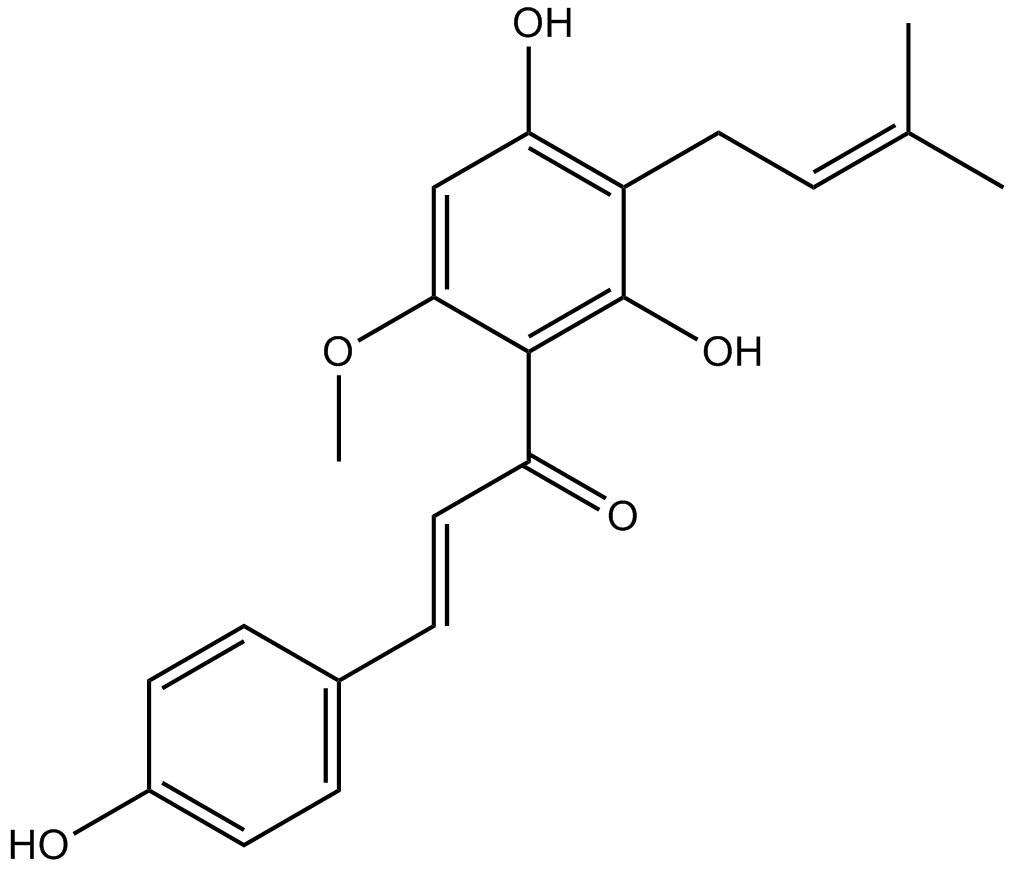Xanthohumol |
| Katalog-Nr.GC12391 |
Xanthohumol ist eines der wichtigsten aus Hopfen isolierten Flavonoide, der Inhibitor der Diacylglycerol-Acetyltransferase (DGAT), COX-1 und COX-2, und zeigt Antikrebs- und Antiangiogenese-AktivitÄten.
Products are for research use only. Not for human use. We do not sell to patients.

Cas No.: 6754-58-1
Sample solution is provided at 25 µL, 10mM.
Xanthohumol is one of the principal flavonoids isolated from hops, the inhibitor of diacylglycerol acetyltransferase (DGAT), COX-1 and COX-2, and shows anti-cancer and anti-angiogenic activities.
Xanthohumol significantly attenuates ADP-induced blood platelet aggregation, and significantly reduces the expression of fibrinogen receptor (activated form of GPIIbIIIa) on platelets' surface[1]. Xanthohumol (5-50 nM) reduces the frequency of spontaneously occurring Ca2+ sparks and Ca2+ waves in control myocytes and in cells subjected to Ca2+ overload caused by: (1) exposure to low K+ solutions, (2) periods of high frequency electrical stimulation, (3) exposures to isoproterenol or (4) caffeine. Xanthohumol (50-100 nM) reduces the rate of relaxation of electrically- or caffeine-triggered Ca2+ transients, without suppressing ICa, but this effect is small and reversed by isoproterenol at physiological temperatures. Xanthohumol also suppresses the Ca2+ content of the SR, and its rate of recirculation[2]. Treatment of endothelial cells with Xanthohumol leads to increased AMPK phosphorylation and activity. Functional studies using biochemical approaches confirm that AMPK mediates Xanthohumol anti-angiogenic activity. AMPK activation by Xanthohumol is mediated by CAMMKβ, but not LKB1. Analysis of the downstream mechanisms shows that Xanthohumol-induced AMPK activation reduces nitric oxide (NO) levels in endothelial cells by decreasing eNOS phosphorylation. Finally, AKT pathway is inactivated by Xanthohumol as part of its anti-angiogenic activity, but independently from AMPK, suggesting that these two signaling pathways proceed autonomously[3]. Xanthohumol significantly reduces cell viability and induces apoptosis via pro-caspase-3/8 cleavage and poly(ADP ribose) polymerase (PARP) degradation. Pro-caspase-9 cleavage, Bcl2 family expression changes, mitochondrial dysfunction, and intracellular ROS generation also participate in Xanthohumol-induced glioma cell death. Xanthohumol's inhibition of the IGFBP2/AKT/Bcl2 pathway via miR-204-3p targeting plays a critical role in mediating glioma cell death[4].
References:
[1]. Luzak B, et al. Xanthohumol from hop cones (Humulus lupulus L.) prevents ADP-induced platelet reactivity. Arch Physiol Biochem. 2016 Nov 18:1-7
[2]. Arnaiz-Cot JJ, et al. Xanthohumol modulates calcium signaling in rat ventricular myocytes: Possible Antiarrhythmic properties. J Pharmacol Exp Ther. 2016 Nov 4. pii: jpet.116.236588
[3]. Gallo C, et al. Hop derived flavonoid xanthohumol inhibits endothelial cell functions via AMPK activation. Oncotarget. 2016 Aug 1
[4]. Chen PH, et al. The miR-204-3p-targeted IGFBP2 pathway is involved in xanthohumol-induced glioma cell apoptotic death. Neuropharmacology. 2016 Nov;110(Pt A):362-75.
Average Rating: 5 (Based on Reviews and 10 reference(s) in Google Scholar.)
GLPBIO products are for RESEARCH USE ONLY. Please make sure your review or question is research based.
Required fields are marked with *




















